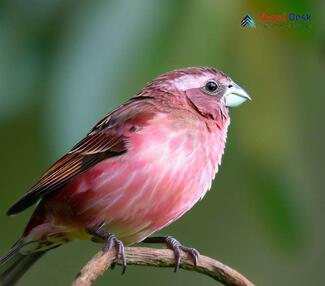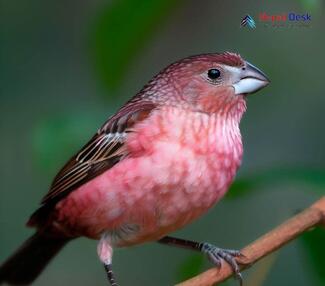Nepal, renowned for its magnificent Himalayan mountain range and vibrant cultural heritage, is also home to an abundance of uniquely beautiful bird species. One such captivating creature is the Dark-rumped Rosefinch (Carpodacus edwardsii) - a charming and petite songbird, found primarily in Nepal's mountainous regions. This partial migratory bird is a species of finch in the family Fringillidae. In this article, we shall delve into the fascinating world of the Dark-rumped Rosefinch, exploring its habitat, appearance, and behavior.
A home among the high altitudes
Nepal's diverse landscape creates an ideal environment for numerous bird species, and the Dark-rumped Rosefinch is no exception. This particular species thrives between 3,000 and 4,400 meters (9,800 - 14,400 ft) above sea level in the alpine shrublands and coniferous forests of Nepal. They are often sighted in areas like Langtang National Park and Sagarmatha National Park within coniferous or mixed forests consisting of silver fir, birch, or rhododendron trees.
Cherished for their striking colors
One of the most appealing aspects of these tiny birds is their vibrant plumage. Males boast a bright crimson-red head and breast that transitions to a duller shade as it stretches along their back. Their rump exudes a dark brown hue, hence the name "Dark-rumped." While females exhibit more subdued colors – primarily a blend of grays and browns – they still possess hints of red on their feathers.
Serene serenades
Similar to other Finches within their family Fringillidae, Dark-rumped Rosefinches are known for their soft yet melodious calls. Birdwatchers visiting Nepal are often enchanted by their tuneful vocalizations that resonate through the lush mountain forests.
Survival and adaptation
To withstand the extreme conditions and the unforgiving winters of their high-altitude habitat, Dark-rumped Rosefinches have developed adaptive strategies. Their feathers thicken during the colder months, allowing them to retain warmth. Additionally, these agile birds primarily feed on seeds and buds, allowing them to forage efficiently in their chilly surroundings.
Witnessing the ethereal beauty of the Dark-rumped Rosefinch is undoubtedly a memorable experience for any nature lover or birdwatching enthusiast visiting Nepal. As we continue to learn more about this fascinating species and its mountainous environment, we are reminded of the incredible diversity that can be found within nature's most secluded corners.


